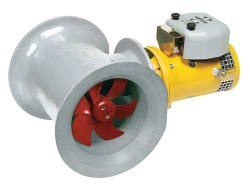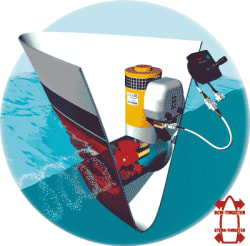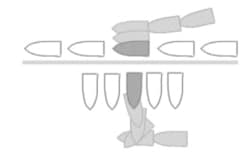While some old salts might feel that bow thrusters are only for inexperienced boaters, you'd be hard pressed to find a boater that hasn't wished they had one at some point while they were trying to dock their boat.
 As boats get bigger and docks stay the same, the space left to land our boat seems to get smaller all the time - making that cross-wind and tidal ebb ever so challenging! Sometimes you just need a little peace of mind and a new bow thruster could be just the thing to provide it. A thruster gives you positive control of your vessel when docking in high wind or current, during tight maneuvering, or in slow speed/poor steerage situations. Thrusters are laterally operating propellers which move a boat sideways. They are normally installed at the bow, since this is inevitably the most difficult part of the boat to control. In some cases maneuvering capabilities are enhanced when an additional thruster is mounted at the stern, giving larger vessels the potential to practically pivot in place.
As boats get bigger and docks stay the same, the space left to land our boat seems to get smaller all the time - making that cross-wind and tidal ebb ever so challenging! Sometimes you just need a little peace of mind and a new bow thruster could be just the thing to provide it. A thruster gives you positive control of your vessel when docking in high wind or current, during tight maneuvering, or in slow speed/poor steerage situations. Thrusters are laterally operating propellers which move a boat sideways. They are normally installed at the bow, since this is inevitably the most difficult part of the boat to control. In some cases maneuvering capabilities are enhanced when an additional thruster is mounted at the stern, giving larger vessels the potential to practically pivot in place.
 Bow thrusters may be electrically or hydraulically driven. Hydraulic thrusters offer significant weight savings, extended motor running times and increased thrust over comparable electric units. However, they need to be run from an external hydraulic power source, usually a pump coupled to the boat's main engine, potentially making installation more complex. A complete thruster system includes the thruster, a tubular “tunnel” which penetrates the hull and contains the propeller, a control panel, over-current protection and a power source with connecting cables. These items, plus a number of accessories including footswitches, remote panels, retraction devices, and noise reduction kits are all available through Fisheries Supply from popular manufacturers like Lewmar, Vetus and Side-Power.
Bow thrusters may be electrically or hydraulically driven. Hydraulic thrusters offer significant weight savings, extended motor running times and increased thrust over comparable electric units. However, they need to be run from an external hydraulic power source, usually a pump coupled to the boat's main engine, potentially making installation more complex. A complete thruster system includes the thruster, a tubular “tunnel” which penetrates the hull and contains the propeller, a control panel, over-current protection and a power source with connecting cables. These items, plus a number of accessories including footswitches, remote panels, retraction devices, and noise reduction kits are all available through Fisheries Supply from popular manufacturers like Lewmar, Vetus and Side-Power.
With so many variables involved in thruster selection it may be best to rely on the “typical” installation recommendations supplied by manufacturers. These are generally based on the capacity (horsepower or Watts) of the unit's motor. The prudent purchaser, however, will make allowances for any exceptional characteristics of the boat or moorage situation – particularly those relating to windage.
 Some important installation considerations in thruster system performance are adequate voltage at the motor (correctly sized wires) and skilled tunnel installation – this is one thing worth having done by an expert. When applicable, install the tunnel so it is above the waterline when the vessel is on a plane, but at rest the top of the tunnel should be at least half a diameter below the waterline (preferably 1½ times the diameter below); optimum tunnel length is approximately 2 to 4 times its diameter. When sizing for a stern thruster, the general rule is to go one size smaller than your bow thruster. Make sure that the drive unit is within arm's reach for maintenance purposes.
Some important installation considerations in thruster system performance are adequate voltage at the motor (correctly sized wires) and skilled tunnel installation – this is one thing worth having done by an expert. When applicable, install the tunnel so it is above the waterline when the vessel is on a plane, but at rest the top of the tunnel should be at least half a diameter below the waterline (preferably 1½ times the diameter below); optimum tunnel length is approximately 2 to 4 times its diameter. When sizing for a stern thruster, the general rule is to go one size smaller than your bow thruster. Make sure that the drive unit is within arm's reach for maintenance purposes.
We hope you've enjoyed this Navigator, but if you still have questions, please don't hesitate to contact our product experts at (800) 426-6930.


